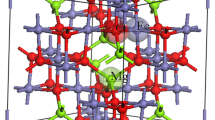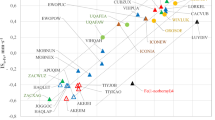Abstract
A number of mixed valence iron oxides and silicates (e.g., magnetite, ilvaite) exhibit thermally induced electron delocalization between adjacent Fe2+ and Fe3+ ions and optically induced electronic transitions which are assigned to Fe2+→Fe3+ intervalence charge transfer.
In this paper, the mechanism of electron delocalization (i.e., polarons versus itinerant electrons) and the nature of optically induced intervalence charge-transfer in minerals are investigated using molecular orbital theory. SCF-Xα-SW molecular orbital calculations were done for several mixed-valence (Fe2O10)15− clusters corresponding to edgesharing Fe2+ and Fe3+ coordination polyhedra. A spinunrestricted formalism was used so that the effect of ferromagnetic versus antiferromagnetic coupling of adjacent Fe2+ and Fe3+ cations could be determined. The molecular orbital results can be related to the polaron theory of solid state physics and the perturbation theory formalism used by Robin and Day (1967) and others to describe electron transfer in mixed valence compounds.
Intervalence charge-transfer results from the overlap of Fe(3d) orbitals across the shared edges of adjacent FeO6 polyhedra to give weak Fe-Fe bonds. Electron delocalization, however, requires that adjacent Fe cations be ferromagnetically coupled. Antiferromagnetic coupling results in distinguishable Fe2+ and Fe3+ cations.
Electronic transitions between the Fe-Fe bonding and Fe-Fe antibonding orbitals results in the optically-induced intervalence charge transfer bands observed in the electronic spectra of mixed valence minerals. Such transitions are predicted to be polarized along the metal-metal bond direction, in agreement with experimental observations.
Similar content being viewed by others
References
Amthauer G, Rossman GR (1984) Mixed valence of iron in minerals with cation clusters. Phys Chem Minerals 11:37–51
Austin IG, Mott NF (1969) Polarons in crystalline and non-crystalline materials. Adv Phys 18:41–102
Burns RG (1981) Intervalence transitions in mixed valence minerals of iron and titanium. Ann Rev Earth Planet Sci 9:345–383
Burns RG, Nolet DA, Parkin KM, McCammon CA, Schwartz KB (1980) Mixed valence minerals of iron and titanium: correlations of structural, Mossbauer, and electronic spectral data. In Mixed-Valence Compounds, Brown DB, (ed), D. Reidel: Dordrecht, Netherlands, pp 295–336
Coey JMD, Mourkarika A, McDonagh CM (1982) Electron hopping in cronstedite. Solid State Commun 41:797–800
Coey JMD, Mourkarika A, Ballet O (1982b) Magnetic order in silicate minerals. J Appl Phys 53:8320–8325
Cohen-Tanoudji C, Diu B, Laloe F (1977) Quantum Mechanics. p 420 New York: Interscience
Evans BJ, Amthauer G (1980) The electronic structure of ilvaite and the pressure and temperature dependence of its 57Fe Mossbauer spectrum. J Phys Chem Solids 41:985–1001
Faye GH (1968) The optical absorption spectra of iron in six-coordinated sites in chlorite, biotite, phlogopite and vivianite. Some aspects of pleochroism in the sheet silicates. Can Mineral 15:403–425
Ghose S, Sen Gupta PK, Schlemper EO (1985) Electron ordering in ilvaite, a mixed valence iron silicate: crystal structure refinement at 138 K. Am Mineral 70:1248–1252
Goodenough JB (1971) Metallic oxides. Prog Solid State Chem 5:1–145
Goodenough JB (1980) The Verwey transition revisited. In: Mixed-Valence Compounds. Brown DB (ed) D. Reidel, Dordrecht, Netherlands, 413–425
Gubanov VA, Ellis DE (1980) Magnetic transition state approach to antiferromagnetic ordering: NiO. Phys Rev Lett 44:1633–1636
Hush NS (1967) Intervalence transfer absorption. Part 2. Theoretical considerations and spectroscopic data. Prog Inorg Chem 8:391–444
Hush NS (1980) Electron delocalization, structure and dynamics in mixed-valence systems. In: Mixed Valence Compounds. Brown ED (ed), D. Reidel: Dordrecht, Netherlands, 151–188
Johnson KH (1973) Scattered wave theory of the chemical bond. Adv Quantum Chem 7:143–185
Kan X, Coey JMD (1985) Mossbauer spectra, magnetic and electrical properties of laihunite, a mixed valence iron olivine mineral. Am Mineral 70:576–580
Meyer TJ (1980) Electron transfer in mixed valence compounds. In: Mixed Valence Compounds. Brown DB (ed) D. Reidel, Dordrecht, Netherlands, pp 75–114
Moglestue KT (1968) Exchange integrals in magnetite. Neutron inelastic scattering vol. 2, IAEA Symp., Copenhagen, 117–122
Norman JG (1976) Non-empirical versus empirical choices for overlapping sphere radii ratios in SCF-Xα-SW calculations on ClO −4 and SO2. Mol Phys 31:1191–1198
Pollack H, Quartier R, Bruyneel W (1981) Electron relaxation in deerite. Phys Chem Minerals 7:10–14
Robin MB, Day P (1967) Mixed valence chemistry — a survey and classification. Adv Inorg Radiochem 10:247–422
Schwarz K (1972) Optimization of the statistical exchange parameter α for the free ions H through Nb. Phys Rev B5:2466–2468
Sherman DM (1984) Electronic structures of manganese oxide minerals. Am Mineral 69:788–799
Sherman DM (1985) The electronic structures of Fe3+ coordination sites in ion oxides; applications to spectra, bonding and magnetism. Phys Chem Mineral 12:161–175
Sherman DM, Waite TD (1985) Electronic spectra of Fe3+ oxides in the near UV to near IR. Am Mineral 70:1262–1269
Slater JC (1974) The Self-consistent field method for atoms, molecules and solids. McGraw Hill, New York
Smith G (1978) Evidence for absorption by exchange coupled Fe2+-Fe3+ pairs in the near infrared spectra of minerals. Phys Chem Minerals 3:375–385
Strens RGJ, Wood BJ (1979) Diffuse reflectance spectra and optical properties of some iron and titanium oxides and oxyhydroxides. Miner Mag 43:347–354
Tossell JA (1985) Quantum mechanical models in mineralogy. In: Chemical bonding and Spectroscopy in Mineral Chemistry. Berry FJ, Vaughan DJ (eds) Chapman and Hall, London, pp 1–30
Tricker MJ, Vaishnava PP, Manning PG (1981) 57Fe Mossbauer spectroscopic studies of electron hopping processes in vesuvianites. J Inorg Nucl Chem 43:1169–1174
Vaughan DJ (1985) Spectroscopy and chemical bonding in the opaque minerals. In: Chemical Bonding and Spectroscopy in Mineral Chemistry. Berry FJ, Vaughan DJ (eds) Chapman and Hall, London, 251–292
Wong KY, Schatz PN (1981) A dynamic model for mixed-valence compounds. Prog Inorg Chem 38:369–450
Author information
Authors and Affiliations
Rights and permissions
About this article
Cite this article
Sherman, D.M. Molecular orbital (SCF-Xα-SW) theory of metal-metal charge transfer processes in minerals. Phys Chem Minerals 14, 355–363 (1987). https://doi.org/10.1007/BF00309810
Received:
Issue Date:
DOI: https://doi.org/10.1007/BF00309810




